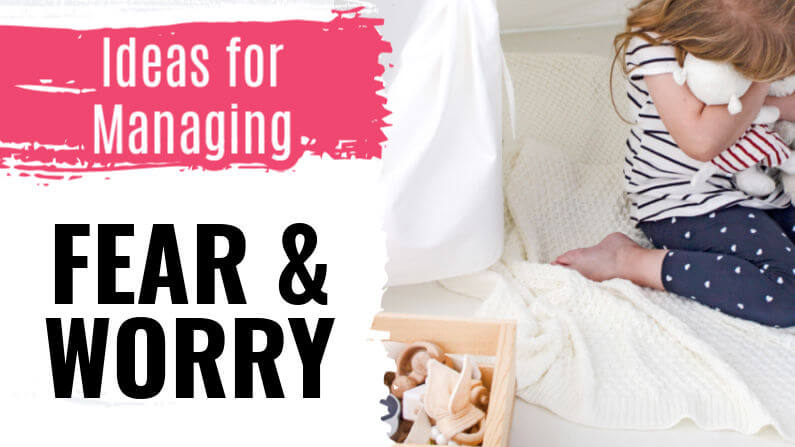Here’s the thing – when you are searching the internet, scouring articles, asking yourself: “What can I do to help my scared child?” – there is a sense that if you could just find the right technique, solution, or resource, that you could “fix” you kid.
The allure of that idea is strong when you’re in the trenches of dealing with a child who is struggling with fears, worries, and anxiety.
The hard truth is that for most kids if you are to the point of researching solutions, you probably aren’t going to be able to “fix” your child or the problem with a little monster spray or even by teaching them how to do deep breathing.
All of those resources can be helpful, but if your child is really struggling with their fear and anxiety, they might be someone who will always have fears and anxieties. That may be the way that they process their emotions – through anxiety, worry, and fear.
This post may contain affiliate links.
How Can I Help My Scared Child?
We all have coping mechanisms and behaviors that we are more drawn to. Some people get depressed, or angry, or choose to numb out/check out, and some people get anxious and worried.
The trick, for anyone struggling with big emotions like fear, is to learn to recognize the triggers that lead to those negative emotions/thoughts/behaviors and find ways to move through them rather than letting them control your life.
You Can’t FIX Your Child’s Fear and Anxiety.
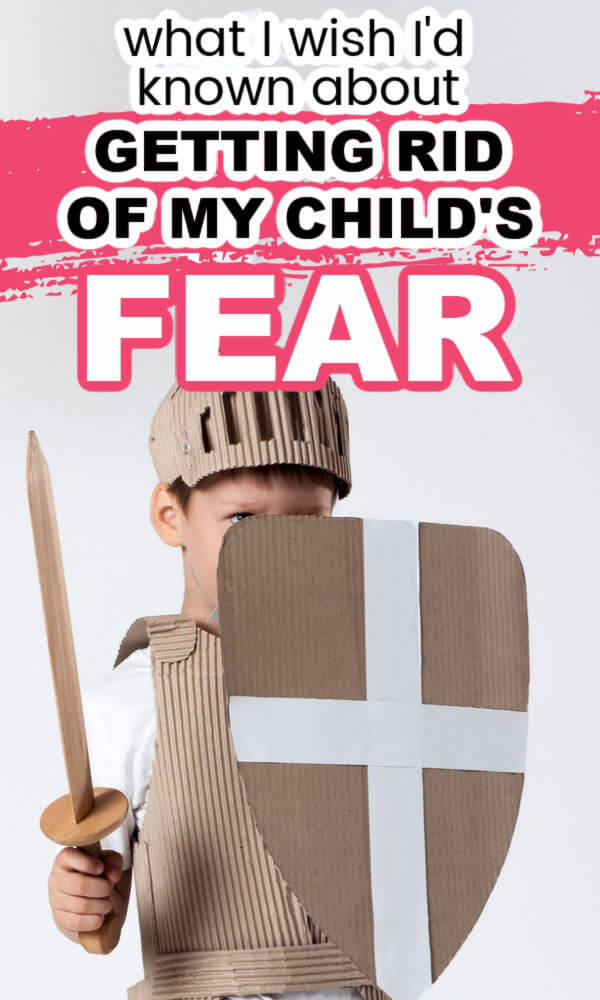
When you approach your child with the idea that they have a problem or that their fear is something that needs to be fixed, you can wind up feeling pretty frustrated.
The good news is that as your child’s parent, fixing their fear issues or getting rid of their fear isn’t your job.
Your job is to teach your children skills and help them practice so that they become experts at working through their anxiety and fear.
When you are able to shift your mindset away from feeling like you need to fix your child, the problem becomes much more manageable. The reality is that you probably weren’t having much success trying to force your child to stop being scared.
When your goal switches from eliminating all fear to teaching skills to cope with fear, you are able to find a direction that can be successful. (Plus, teaching your child to cope with their fear will be a lifelong valuable lesson!)
Your Role in Parenting a Child Who Struggles with Fear and Anxiety
Your role in your child’s life in all things really is to teach them the skills needed to be successful adults. It is the same when it comes to dealing with tough emotions and behaviors. Your role in your child’s fear and anxiety is to teach them how to deal with it in ways that don’t cripple them.
You want to give them the skill set that allows them to feel afraid but to still do whatever it is they are supposed to, or want to, do.
Being afraid or feeling anxious, isn’t necessarily a bad thing. In fact, it can be a very helpful emotion that alerts us to dangerous situations. Fear and anxiety only become an issue when they trigger unwanted thoughts and behaviors.
Realizing this and working from this direction takes a lot of the shame and blame out of fear and anxiety which can really open your child up to learning and using coping strategies to work through their fears.
How to Help Your Child Choose to Learn Coping Skills to Manage Their Fear
If this shift resonates with you, if you have been on the shame or blame train about your child’s fear, or if you have been seeing them feeling really discouraged and frustrated that they aren’t “getting better,” then I would recommend having this talk:
1) Talk to your child about fear and anxiety being helpful emotions – give them an example of why fear is a really good emotion (use something that isn’t too similar to what your child is afraid of): you could talk about how feeling fearful when you are standing near the edge of a cliff is a helpful emotion to keep you from falling, or you could talk about how seeing an animal in the wild might make you feel afraid which is a helpful survival instinct.
2) Reinforce that fear isn’t bad, that they are not in trouble but that you want to help them not feel so stuck by their fear.
3) Tell your child that even grownups feel afraid, including you, and that the way you deal with it is to use different skills so that your fear doesn’t make it impossible for you to do the things you want to do.
If you are able, give them an example from your life that is honest and vulnerable. (Modeling openness about your fear is a way to teach your child that it is okay to talk about our fears and emotions which is a coping skill.)
4) Let your child know that there are skills he or she can learn. That these skills will help them accomplish what they want or need to do even when they are feeling afraid. And, that using those skills and working through their fears will, hopefully, help to lessen them over time.
Your Child’s Role in Managing Their Fear
Now that we have shifted your mindset and your goals around helping your child, it is important to quickly touch on what we want to see from your child.
Ideally, they will come to a place where they feel empowered to take charge of their fear and anxiety. A place where they feel confident and competent enough to use coping skills to work through their feelings and accomplish everything they set their minds to.
This may not be where your child is at as you shift into this new way of dealing with their fear. They may be feeling so worried, frustrated, and hopeless that the idea of being responsible for their behavior and thoughts is just too much.
If this is where your child is at. If you see them resisting by saying things like, “I can’t” or becoming needier, be patient. Treat those emotions the same way that you are treating their original fear.
Honestly, this kind of resistance is just another outpouring of their anxiety. Become their greatest cheerleader. Notice every small step they take and pile on the praise.
Positive reinforcement and consistency will eventually give them the courage they need to take responsibility and start moving through their fears rather than being paralyzed by them.
Skills and Lessons to Teach Your Scared Child
Once you and your child have come to a place of recognizing that you want to learn skills to help cope with the fear, rather than find a way to fix or get rid of the fear all together, then you can start the important work of skill building.
The first step in learning to manage fear is to learn to better understand your fear.
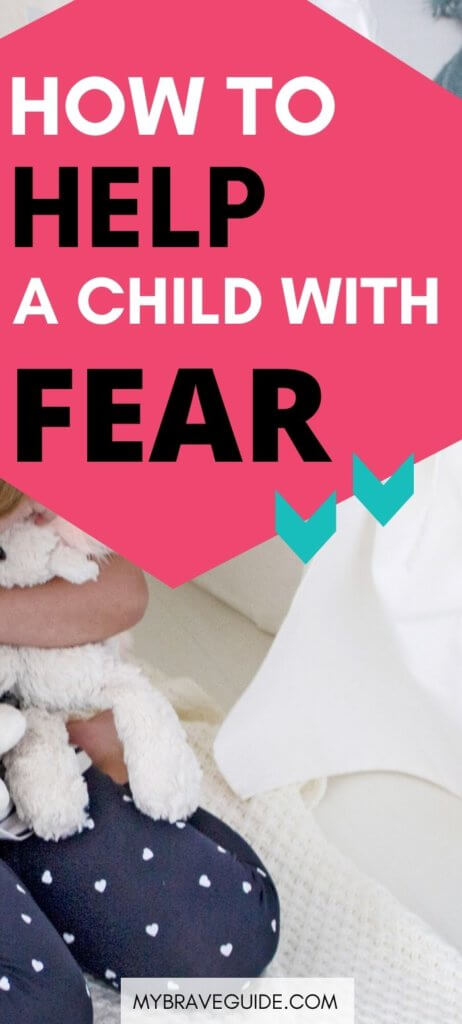
Understanding the Early Signs of Anxiety
At times, you may look at your child in the middle of full-on panic, meltdown, and near hysteria and wonder, how did we get here? Why are we here (again?!?) It can seem like fear comes on so fast and hits so hard.
In reality, there are many early warning signs before your child gets to the full-blown fear stage. Paying attention to these signs is one of the first steps in getting to a place where fear, and the behaviors that accompany it, aren’t overwhelming your child.
There are two different angles that are important to address when working on learning to recognize early warning signs.
First, you, as the parent, need to find the outward warning signs that you can help with.
Second, your child needs to learn their own inner warning signs and find ways to recognize and calm down in this stage.
Recognizing Triggers as a Parent
Before I jump into this important step, I want to preface this by saying that as a parent, it is important to realize that your child is going to be their own best defense when it comes to fear. You will not be able to solve this problem for them. The more you try, the more frustrated, out-of-control, and overwhelmed you will both feel.
That being said, there are some things you can do to help recognize and lessen some of the triggers to fear that are setting off your child while they learn the skills to manage and overcome their fear.
For my son, bedtime is his nemesis. He hates to sleep alone. He is afraid of the dark. He is really worried that there are monsters living in the heating vents… Along with this, he is afraid all throughout the day to be in a room alone and/or to have to go upstairs by himself.
As his parent, it feels important to understand what is triggering his fear. When I know that he is afraid of being in a room alone and I ask him to go upstairs, by himself, to brush his teeth, he is going to start having some fear issue. Similarly, as bedtime approaches, I know that the time of day and the signals that we are about to start our bedtime routine are going to trigger his fear.
Understanding Fear Triggers
As a parent, when you are noticing fear triggers, it helps you see beyond the negative behaviors and get to the root of the problem.
It is natural to look at your child’s behaviors when they are feeling triggered and assume that they are just misbehaving.
For example, your child may refuse to go upstairs and brush their teeth. You might assume that they are being defiant and need to have a consequense.
In reality, their refusal may not actually be deliberate defiance. Instead, it may be a reaction to their fear which is getting out of control when they start thinking of being alone upstairs.
In these kind of moments, your child may not be able to tell you that they are feeling afraid.
It can be incredibly helpful to begin to notice and recognize these kind of triggers.
You can look for patterns in your child’s behavior. For example, maybe they really struggle to get ready to go to school every morning. (This could point towards them having some school or social anxiety.) Or, maybe they become very needy and clingy in the evenings as bedtime approaches. (This could signal that the normal bedtime routine is triggering their bedtime fear issues.)
How to recognize Your Child’s Fear Triggers
Here are some questions that should help you start to recognize some of your child’s fear triggers:
- Is there a time of day that my child seems more afraid than others?
- Are there any activities that my child reacts to in a way that doesn’t seem to match the moment?
- Are there people, places, or activities that my child really resists or doesn’t like?
- Are there any patterns of misbehavior or acting out around transitions, tasks, etc.?
What to do with Fear Triggers
There may be some things you can adjust to help your child work through their fears. For example, you could allow your child to brush their teeth downstairs rather than requiring them to go upstairs alone.
It will also be helpful to think through out of the box ideas. For example, it is not realistic that you accompany your child upstairs every time they need to do something. Walkie Talkies could be a creative option that would help with the trigger of being alone.
Sometimes it is also helpful to work through a fear together. For example, if your child is really afraid of the dark, you might lie with them in their bedroom with the lights off. Ask them to point out what is scary. If they are noticing patterns from the street lights hitting the blinds, showing them what is causing that may help.
Some triggers are not going to be able to be eliminated. When you come up against these types of fear triggers, it is important to allow your children to start taking ownership of their fear and find ways to work through, get rid of, or avoid the triggers on their own.
How to Help Your Child Recognize and Manage Their Fear Triggers
When it comes to helping your child recognize, understand, and work through their fear triggers, they will need your help and guidance. While the goal is for them to become self-sufficient at recognizing the fear and calming themselves down, the coping skills needed to do this are ones that need to be learned.
Help Your Child Recognize Fear
To start this process, have a conversation with your child about what fear feels like in their body and in their mind so that they are able to recognize it.
This is one of the early exercises in my printable workbook The Little Brave Guide to Being Afraid because it is such an important step for children in overcoming their fear. You can check out the workbook in my shop.
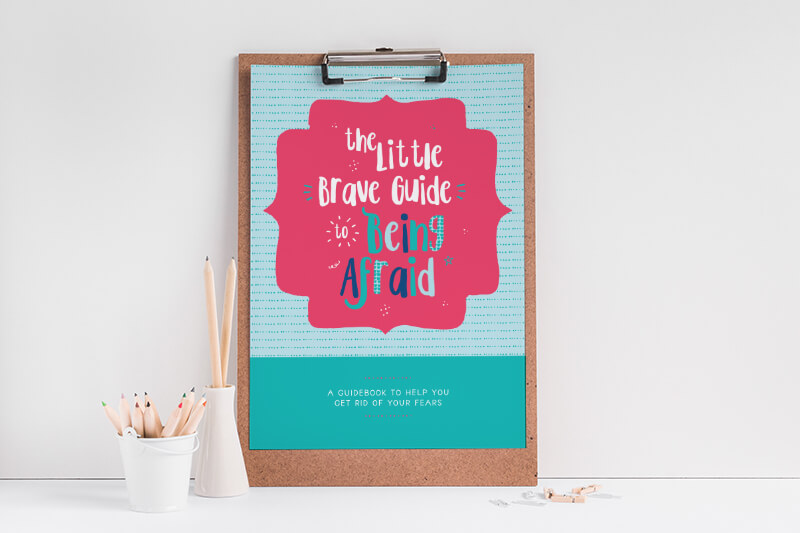
Help Your Child Identify Fear Triggers
Next, talk about what types of activities, events, people, places, etc. make your child feel fear. Ask them to rate the level of fear for each event, person, place, etc. (Again, this is one of the exercises in the Little Brave Guide to Being Afraid.)
Help Your Child Talk About What They Are Scared Of
Finally, ask them to talk about what they are afraid of. One question that helps with this is to ask, “what is the worst that could happen?”
Other helpful ways to “talk about” what they are afraid of, for some kids, is to have them draw what fear feels like. Or, have them act out what fear feels like or what they are scared of.
Helping Children Overcome Their Fear Triggers
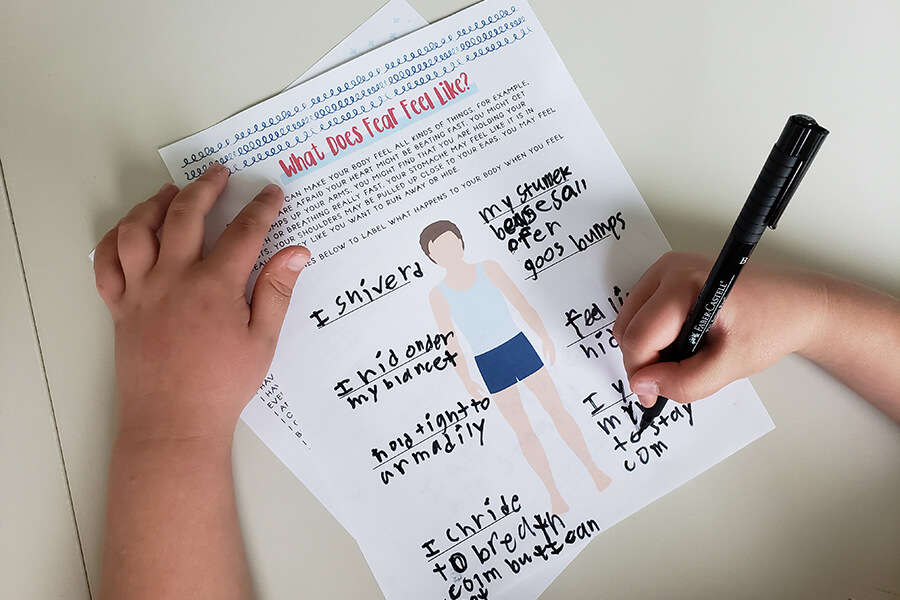
Once your child is more aware of their fear triggers, you will be able to start making plans to deal with the triggers. For some of their triggers, they will be able to find ways to avoid the situation altogether. For others, they will need to use coping skills to get through.
Ideally, you will be able to come to a place where your child is addressing their fear at the early stage so that it is not getting into that full-blown terror mode.
For example, with my son, he was able to recognize that going upstairs to start getting ready for bed is a trigger for him. He has a plan to ask myself or my husband to come up with him when he is getting ready for bed (avoiding the trigger.) If that is not possible, he knows that he can start using coping skills.
Finding Coping Skills and Activities That Help Your Scared Child
You have probably tried a number of different ideas to get rid of your child’s fear. As we have discussed, if your goal is getting rid of fear, you are likely to wind up disappointed and frustrated.
Instead, work with your child to find skills and activities that help them work through their fear.
The activities can help by distracting them. They can help by calming their body and mind. Or, they can help by reminding them that they are safe, capable, and in control.
52 Activities to Help a Scared Child
If you are still asking yourself, “What Can I Do to Help My Scared Child” this list may be a good place to start. Here are many different ideas for coping skills that your child can try out.
- Shake a Glitter Calm Down Jar(This one has an LED light in it so it works great for nighttime fears.)
- Read a Book
- Use a Sound Machine to Block Out Scary Noises
- 5 Senses Scavenger Hunt (Check out my Coping Skills Cards for Instructions/Prompts)
- Count To 20
- Squeeze a Stress Ball
- Do Infinity Breathing
- Think of a Happy Memory
- Do Dragon Breathing For 1 Minute
- Use Coping Skills Cards
- Clench and Release Your Muscles
- Use a Problem-Solving Worksheet (Download a free Printable Worksheet in the Parenting Resource Library)
- Listen to Music
- Try Guided Meditation (Use an App or YouTube Video)
- Blow Bubbles
- Do Belly Breathing Until You Feel Calm
- Put on Noise Reducing Headphones
- Snuggle a Stuffed Animal
- Pretend Your Fear is a Bogart (from Harry Potter) and Find Ways to Make it Seem Silly
- Write in a Journal
- Hum or Whistle to Yourself
- Say the ABCs Backwards
- Do Mountain Breathing
- Do an Activity Out of the Little Brave Guide to Being Afraid
- Blow on a Pinwheel
- Play with a Fidget Spinner
- Color a Picture
- Squeeze a Pillow as Tight as You Can
- Let Someone Brush Your Hair
- Use a Weighted Blanket (Make sure to get the right weight for your child. This is the one my son has – I like it because it is washable)
- Take a Bubble Bath
- Listen to an Audio Book or Story
- Use Lavender Essential Oil
- Make a Safety Zone Fort in Your Room
- Doodle – Alternate Between Light and Heavy Pressure
- Write Down Your Worries or Fears and Then Tear Up the Paper
- Say a Positive Affirmation
- Do a Body Scan (Check out my Coping Skills Cards for Instructions/Prompts)
- Play with a Pipe Cleaner
- Trace a Calming Word on Your Leg or Arm
- Play with Thinking Putty (This “Dino Poop” Putty makes my son laugh which also helps to reign in his fear.)
- Talk Through “What’s the Worst that Could Happen”
- Talk to a Counselor
- Do Hot Cocoa Breathing
- Look at Old Pictures
- Make a Worry Monster
- Do an ABC Scavenger Hunt
- Play with A Rubix Cube
- Make a Token to Keep with You to Remind You to be Brave
- Write a Letter or a Story about Your Fears
- Pretend You Are Calm Even If You’re Not
- Remember Every Detail You Can About the Most Beautiful Place You Have Every Been
What Can I Do to Help My Scared Child
In summary, helping your scared child is a process. If your goal is to “fix” your child, you will most likely end up frustrated. However, there are many things you can do to help including:
- Recognize Fear Triggers
- Eliminate Fear Triggers as Possible
- Teach Your Child to Respond to Their Fear Triggers
- Teach Your Child to Use Coping Skills to Manage Their Fear.
Other Resources for Scared Kids (and Their Parents)
10 Ideas to Help Kids Who Are Scared at Night
